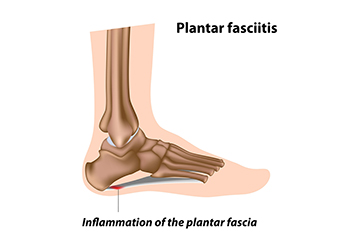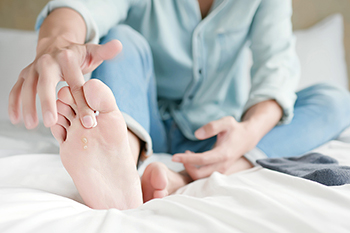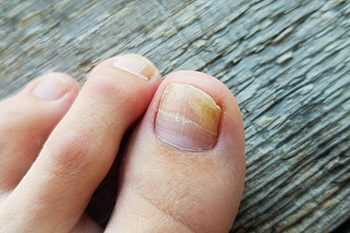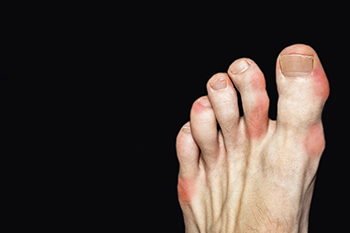Kirksville (660) 665-9000
July 2022
Preventing Plantar Fasciitis in Runners

One of the most common sources of foot pain is a condition known as plantar fasciitis. This foot affliction usually results in heel pain and affects the plantar fascia, or the band of tissue that runs between the heel and the toes. Many people who suffer from plantar fasciitis will experience sharp heel pain. Runners are one group of individuals that are at risk of developing plantar fasciitis, which can make running significantly more difficult and painful. There are several steps that runners can take to essentially decrease their risk of developing plantar fasciitis from running. First, runners can be intentional about choosing what surfaces they run on. Specifically, runners can choose to run on soft, rather than hard surfaces to ultimately reduce the impact and pressure felt on their heels. Also, to reduce the strain felt on feet, runners can be careful not to increase the distance of their runs by anything more than 10 percent each week. If a runner wants to be particularly proactive, they may choose to also perform a gait analysis with a professional. The purpose of performing this kind of analysis is to try to detect any potentially problematic qualities of the runner’s stride before it leads to issues like plantar fasciitis. If you are a runner and want to learn more about how you can reduce your risk of developing plantar fasciitis, reach out to a podiatrist.
Plantar fasciitis is a common foot condition that is often caused by a strain injury. If you are experiencing heel pain or symptoms of plantar fasciitis, contact Deborah Holte, DPM from Northeast Missouri Foot Clinic. Our doctor can provide the care you need to keep you pain-free and on your feet.
What Is Plantar Fasciitis?
Plantar fasciitis is one of the most common causes of heel pain. The plantar fascia is a ligament that connects your heel to the front of your foot. When this ligament becomes inflamed, plantar fasciitis is the result. If you have plantar fasciitis you will have a stabbing pain that usually occurs with your first steps in the morning. As the day progresses and you walk around more, this pain will start to disappear, but it will return after long periods of standing or sitting.
What Causes Plantar Fasciitis?
- Excessive running
- Having high arches in your feet
- Other foot issues such as flat feet
- Pregnancy (due to the sudden weight gain)
- Being on your feet very often
There are some risk factors that may make you more likely to develop plantar fasciitis compared to others. The condition most commonly affects adults between the ages of 40 and 60. It also tends to affect people who are obese because the extra pounds result in extra stress being placed on the plantar fascia.
Prevention
- Take good care of your feet – Wear shoes that have good arch support and heel cushioning.
- Maintain a healthy weight
- If you are a runner, alternate running with other sports that won’t cause heel pain
There are a variety of treatment options available for plantar fasciitis along with the pain that accompanies it. Additionally, physical therapy is a very important component in the treatment process. It is important that you meet with your podiatrist to determine which treatment option is best for you.
If you have any questions, please feel free to contact our office located in Kirksville, MO . We offer the newest diagnostic and treatment technologies for all your foot care needs.
How a Podiatrist Diagnoses Athlete’s Foot

Athlete’s Foot is one common and potentially uncomfortable issue that can negatively impact the health of your feet. This condition is essentially a fungal infection that is highly contagious. It is most frequently spread to an individual when they fail to wear shoes in highly-trafficked public areas, such as locker rooms and pool sides. Moisture tends to help this fungal infection thrive and spread quickly. The condition can cause redness, itching, and discomfort. There are several different ways that a podiatrist can go about diagnosing a case of athlete's foot. In some cases, a podiatrist may be able to perform the diagnosis by simply observing the symptoms, such as cracking and discoloration. However, in other cases, a podiatrist may need to perform a skin test to properly diagnose the condition. This is known as a skin lesion potassium hydroxide exam. During such an exam, the podiatrist can take a piece of the infected skin and place it in a chemical called potassium hydroxide. This process ultimately isolates the fungus from the other normal skin cells, allowing the doctor to observe the fungus. If you think that you might have developed a case of athlete’s foot, it may be best to reach out to a podiatrist who can use one of these aforementioned methods of diagnosis.
Athlete’s foot is an inconvenient condition that can be easily reduced with the proper treatment. If you have any concerns about your feet and ankles, contact Deborah Holte, DPM from Northeast Missouri Foot Clinic. Our doctor will treat your foot and ankle needs.
Athlete’s Foot: The Sole Story
Athlete's foot, also known as tinea pedis, can be an extremely contagious foot infection. It is commonly contracted in public changing areas and bathrooms, dormitory style living quarters, around locker rooms and public swimming pools, or anywhere your feet often come into contact with other people.
Solutions to Combat Athlete’s Foot
- Hydrate your feet by using lotion
- Exfoliate
- Buff off nails
- Use of anti-fungal products
- Examine your feet and visit your doctor if any suspicious blisters or cuts develop
Athlete’s foot can cause many irritating symptoms such as dry and flaking skin, itching, and redness. Some more severe symptoms can include bleeding and cracked skin, intense itching and burning, and even pain when walking. In the worst cases, Athlete’s foot can cause blistering as well. Speak to your podiatrist for a better understanding of the different causes of Athlete’s foot, as well as help in determining which treatment options are best for you.
If you have any questions please feel free to contact our office located in Kirksville, MO . We offer the newest diagnostic and treatment technologies for all your foot and ankle needs.
Toenail Fungus Is Contagious, and May Be Prevented

Toenail fungus can be an unpleasant and unsightly foot condition, despite the fact it is generally not serious. The majority of people may experience this type of fungus at some point in their lives, and it can be difficult to treat. It occurs as a result of the fungus entering the body through tiny cracks in the skin on the feet. This type of fungus is known to be contagious, and it lives and thrives in warm and moist environments, including shower room floors and locker rooms. It is advised to wear appropriate shoes while in these types of areas, as this can help to stop the spread of toenail fungus. The noticeable symptoms consist of a thickening and yellowing of the toenails, often starting with the big toe. This infection can cause the toenails to become brittle, and they may be difficult to trim correctly. In severe cases, the surrounding skin can become red and irritated, and may begin to itch. Many patients have found effective preventive methods for this type of fungus. These consist of wearing shoes that are made of natural materials, and refraining from sharing towels, shoes, and socks. Additionally, shoes that have been contaminated with this fungus need to be replaced, and keeping the toenails trimmed may aid in helping to prevent toenail fungus. If you are afflicted with this infection, it is suggested that you confer with a podiatrist at the beginning stages who can offer you correct treatment techniques.
For more information about treatment, contact Deborah Holte, DPM of Northeast Missouri Foot Clinic. Our doctor can provide the care you need to keep you pain-free and on your feet.
Toenail Fungus Treatment
Toenail fungus is a condition that affects many people and can be especially hard to get rid of. Fortunately, there are several methods to go about treating and avoiding it.
Antifungals & Deterrence
Oral antifungal medicine has been shown to be effective in many cases. It is important to consult with a podiatrist to determine the proper regiment for you, or potentially explore other options.
Applying foot powder on the feet and shoes helps keep the feet free of moisture and sweat.
Sandals or open toed shoes – Wearing these will allow air movement and help keep feet dry. They also expose your feet to light, which fungus cannot tolerate. Socks with moisture wicking material also help as well.
If you have any questions please feel free to contact our office located in Kirksville, MO . We offer the newest diagnostic tools and technology to treat your foot and ankle needs.
Why Live with Pain and Numbness in Your Feet?
Obesity and Gout

Gout is a form of arthritis that occurs when there are increased levels of uric acid in the blood that is not properly excreted from the body. This uric acid can crystalize and settle in the joints. It is characterized by sudden and severe attacks of pain, swelling, and redness in one or more joints, often the big toe. Gout is sometimes referred to as “a disease of kings” because it often occurred in wealthy men who could afford to overeat and drink alcohol. Weight gain and obesity in adulthood are linked to gout. However, there are many reasons one might develop gout, such as genetics and medical conditions (like kidney disease). The good news is that if one loses weight, gout and gout flares are reduced. Attempt to maintain a healthy body weight through adulthood. If you develop gout, it is suggested that you consult with a podiatrist, who can diagnose the condition and recommend treatment options.
Gout is a painful condition that can be treated. If you are seeking treatment, contact Deborah Holte, DPM from Northeast Missouri Foot Clinic. Our doctor will treat your foot and ankle needs.
What Is Gout?
Gout is a form of arthritis that is characterized by sudden, severe attacks of pain, redness, and tenderness in the joints. The condition usually affects the joint at the base of the big toe. A gout attack can occur at any random time, such as the middle of the night while you are asleep.
Symptoms
- Intense Joint Pain - Usually around the large joint of your big toe, and it most severe within the first four to twelve hours
- Lingering Discomfort - Joint discomfort may last from a few days to a few weeks
- Inflammation and Redness -Affected joints may become swollen, tender, warm and red
- Limited Range of Motion - May experience a decrease in joint mobility
Risk Factors
- Genetics - If family members have gout, you’re more likely to have it
- Medications - Diuretic medications can raise uric acid levels
- Gender/Age - Gout is more common in men until the age of 60. It is believed that estrogen protects women until that point
- Diet - Eating red meat and shellfish increases your risk
- Alcohol - Having more than two alcoholic drinks per day increases your risk
- Obesity - Obese people are at a higher risk for gout
Prior to visiting your podiatrist to receive treatment for gout, there are a few things you should do beforehand. If you have gout you should write down your symptoms--including when they started and how often you experience them, important medical information you may have, and any questions you may have. Writing down these three things will help your podiatrist in assessing your specific situation so that he or she may provide the best route of treatment for you.
If you have any questions, please feel free to contact our office located in Kirksville, MO . We offer the newest diagnostic and treatment technologies for all your foot care needs.





